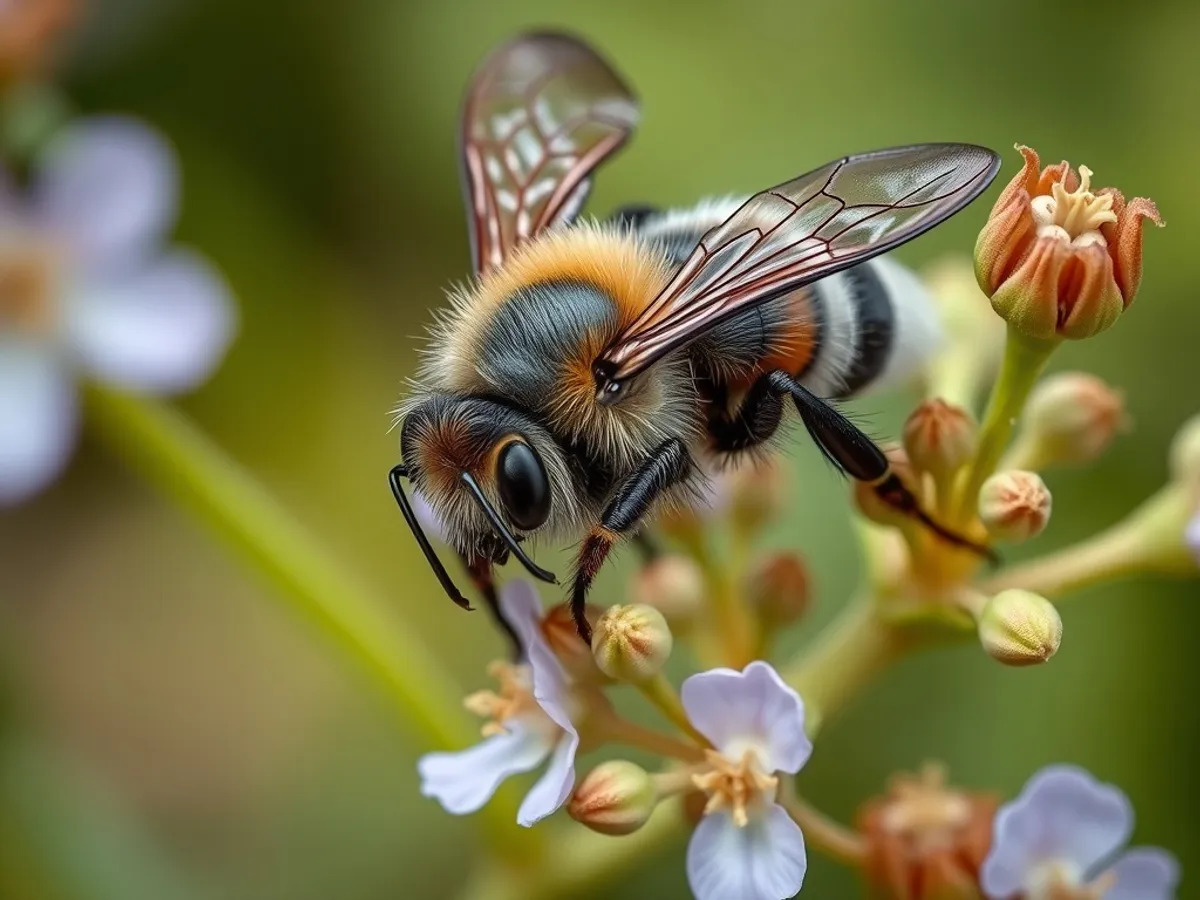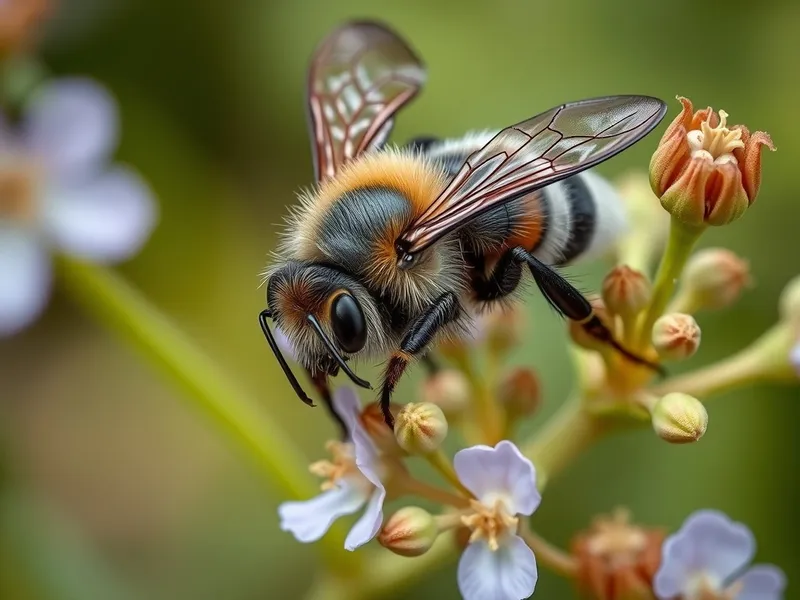
Blue orchard bee
Osmia lignaria

Meet the Blue orchard bee
The blue orchard bee is a solitary, native bee species found across North America, known for its striking metallic blue to greenish coloration. Unlike honey bees, these bees do not form large colonies but nest individually in pre-existing cavities such as hollow stems or wood holes. They are highly valued for their exceptional efficiency in pollinating fruit trees, especially apples, cherries, and almonds. Blue orchard bees are active in early spring, coinciding with orchard bloom, and have become increasingly important in agricultural pollination due to their gentle nature and effectiveness.
Classification
Invertebrate
Habitat
Woodlands, orchards, and gardens
Diet
Herbivore (pollen and nectar)
Lifespan
1 year (adults live 4-8 weeks)
Conservation
Least Concern
Weight
80-120 mg
📖Fascinating Facts
Super Pollinators
A single blue orchard bee can pollinate as many flowers as several honey bees, making them vital for orchard crops.
Solitary Nesters
Each female builds her own nest, often in hollow reeds or drilled holes, partitioned with mud for each offspring.
Early Spring Activity
Blue orchard bees emerge early in the spring, perfectly timed with the blooming period of many fruit trees.
📋Detailed Description
The blue orchard bee (Osmia lignaria) is a robust, medium-sized solitary bee, typically measuring 10–14 mm in length, with females generally larger than males. Its exoskeleton exhibits a striking metallic blue, green, or sometimes purplish sheen, which distinguishes it from many other native bees. The body is densely covered with branched hairs, especially on the ventral surface of the abdomen, which facilitates efficient pollen collection. Unlike social bees, O. lignaria does not form colonies; each female independently constructs and provisions her own nest. Nests are made in pre-existing cavities such as hollow plant stems, beetle holes in wood, or artificial nesting tubes, and are partitioned into brood cells using mud. The species is univoltine, producing one generation per year, with adults emerging in early spring to coincide with the flowering of fruit trees. Males typically emerge several days before females (protandry) and wait near nesting sites to mate. Females exhibit remarkable navigational abilities, using visual landmarks and olfactory cues to locate their nests. Their foraging range is relatively limited, usually within 100–300 meters of the nest, making them highly efficient pollinators for localized crops. The blue orchard bee is cold-tolerant and active at lower temperatures than honey bees, allowing it to forage during cool spring mornings.
💡 Did you know?
Unlike honey bees, blue orchard bees are solitary and do not make honey or wax combs.
🔬Research & Sources
Wikipedia Summary
Osmia lignaria, commonly known as the orchard mason bee or blue orchard bee, is a megachilid bee that makes nests in natural holes and reeds, creating individual cells for its brood that are separated by mud dividers. Unlike carpenter bees, it cannot drill holes in wood. O. lignaria is a common species used for early spring fruit bloom in the United States and Canada, though a number of other Osmia species are cultured for use in pollination.
Last Modified: 7/16/2024
🎭Behavior & Social Structure
Osmia lignaria is diurnal, with peak foraging activity occurring during the morning and early afternoon when temperatures are above 12°C (54°F). Females exhibit strong site fidelity, returning repeatedly to the same nesting cavity. They are generalist foragers but show a preference for early-blooming fruit trees such as apples, cherries, and almonds. Foraging trips are frequent and short, with each trip typically involving the collection of both pollen and nectar, which are mixed to form a provision mass for each brood cell. Unlike honey bees, blue orchard bees do not communicate with conspecifics about food sources, and there is minimal direct interaction between individuals aside from mating. Females are non-aggressive and rarely sting unless handled. Males are territorial near nesting sites but do not defend resources. Daily routines involve alternating periods of foraging, nest construction, and resting. Nesting females are meticulous, using mud to create partitions and seal the nest entrance, which provides protection for developing offspring.
👶Reproduction & Life Cycle
Mating occurs soon after adult emergence in early spring, with males typically waiting near nest entrances to intercept emerging females. After mating, females independently select suitable nesting sites and begin constructing brood cells. Each cell is provisioned with a mixture of pollen and nectar, upon which a single egg is laid. Females control the sex of their offspring by fertilizing eggs (female) or not (male); typically, females are laid deeper in the nest and males closer to the entrance. The developmental period from egg to adult varies with temperature but generally takes 3–4 weeks for larval and pupal stages. After completing development, adults remain in their cocoons in a dormant state (diapause) until the following spring. There is no parental care beyond nest construction and provisioning. The breeding season is tightly synchronized with the blooming period of early spring fruit trees, ensuring optimal food availability for larvae.
🛡️Adaptations & Survival
Osmia lignaria exhibits several adaptations for early spring activity, including a dense covering of insulating hairs and the ability to thermoregulate by shivering their flight muscles to raise body temperature. Their strong mandibles are specialized for manipulating mud and constructing nest partitions. The ventral scopa (pollen-carrying hairs) on the abdomen allows efficient pollen transport, particularly from flowers with exposed anthers. Their solitary nesting behavior reduces the risk of disease transmission common in social bees. The ability to use a wide range of natural and artificial cavities for nesting increases their ecological flexibility. Females possess acute spatial memory, enabling precise navigation to and from nests. Their early emergence and cold tolerance allow them to exploit floral resources before many competitors and predators become active.
📚Research Sources
🎨Cultural Significance
The blue orchard bee has gained prominence in North American agriculture as a managed pollinator, particularly for orchard crops. Its gentle nature and high pollination efficiency have made it a popular alternative to honey bees, especially in small-scale and organic farming. While not traditionally featured in folklore or mythology, O. lignaria is increasingly recognized in environmental education and citizen science programs as a model for native pollinator conservation. The use of 'bee hotels' and artificial nesting blocks has become a symbol of pollinator-friendly gardening and sustainable agriculture.
🔬Recent Research & Discoveries
Recent research has focused on optimizing management practices for O. lignaria in commercial orchards, including studies on nesting substrate preferences, optimal release densities, and the effects of landscape composition on pollination services. Genomic studies have begun to elucidate the genetic basis of cold tolerance and diapause. Investigations into the impacts of pesticides and pathogens on solitary bee health have highlighted the need for pollinator-friendly pest management. Studies on the bee's microbiome and its role in larval development are ongoing. There is also active research into the potential for O. lignaria to supplement or replace honey bees in certain cropping systems, given their resilience to some diseases and their efficiency at low temperatures.
🎥Wildlife Videos

Children of the Sun – Wild Bees
Bees and butterflies play an important role in the pollination of plants and the production of crops for human and animal ...
Free High-Quality Documentaries

An Orchid’s Trap | Wings of Life
#NatGeoWILD #Orchids #WingsOfLife About National Geographic Wild: National Geographic Wild is a place for all things animals ...
Nat Geo Animals

My Garden of a Thousand Bees | PBS Nature Documentary
Watch on your local PBS station, the PBS video app, online, and here on YouTube through October 19, 2025. This program is ...
Nature on PBS

This Bee Works 50 Times Harder than the Honey Bee
Using blue orchard bees to pollinate crops is an idea with a lot of promise. For one thing, they visit 50 times more flowers than ...
Smithsonian Channel

Return of the Wild Honey Bee – Nature’s Forgotten Ally | SLICE WILD | FULL DOC
For millennia, she provided us with honey, perfectly adapted to the flora and climate of central Europe: the European dark bee.
SLICE Wild

Watch This Bee Build Her Bee-jeweled Nest | Deep Look
Pollinator. Mason. Jeweler. A female blue orchard bee is a multitasking master. She fashions exquisite nests out of mud and ...
Deep Look
🌍Habitat Information
The Blue orchard bee typically inhabits Woodlands, orchards, and gardens environments. Blue orchard bees have adapted to their environments with specialized features and behaviors.
Primary Habitat:
Woodlands, orchards, and gardens
More detailed habitat information will be available soon.
🛡️Conservation Status
The Blue orchard bee is currently classified as Least Concern. Conservation efforts are crucial for preserving this species for future generations.
Common Threats:
- 🏠Habitat loss and fragmentation
- 🌡️Climate change impacts
- 🎯Hunting and poaching
- 🏭Human-wildlife conflict
⚠️Threats & Conservation Challenges
While Osmia lignaria is currently listed as Least Concern, several threats could impact populations. Habitat loss due to urbanization, intensive agriculture, and removal of dead wood reduces available nesting sites. Pesticide exposure, particularly neonicotinoids and fungicides, can impair foraging behavior and reproductive success. Climate change may disrupt the synchrony between bee emergence and floral bloom, potentially reducing reproductive output. Pathogens and parasites, such as chalkbrood fungus (Ascosphaera spp.) and mites, can affect larval survival, especially in managed populations. The increasing practice of commercial rearing and movement of bees between regions raises concerns about genetic homogenization and disease spread. Conservation efforts focus on providing suitable nesting habitats, reducing pesticide use, and promoting floral diversity.
🔬Scientific Classification
Scientific Name
Osmia lignaria
Classification Hierarchy
🔍 About Taxonomic Classification
Taxonomic classification is a hierarchical system used by scientists to classify and organize living organisms based on shared characteristics and evolutionary relationships.
The system moves from broad categories (Kingdom) to increasingly specific ones, with each animal's scientific name typically consisting of its Genus and species.
📝Community Notes
Share your observations and insights about the Blue orchard bee with our community of wildlife enthusiasts.
Join Our Community
Sign in to share your observations and connect with fellow wildlife enthusiasts.
Sign In to ContributeNo community notes yet
Be the first to share your observations about the Blue orchard bee!
Explore Blue orchard bee
Select a tab above to learn more about this amazing animal.
📸Photo Gallery
No photos available for this animal yet.
🌟Discover More Wildlife
Continue your journey of discovery with more fascinating animals from our database
